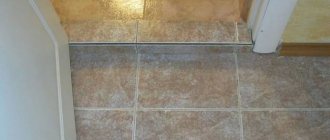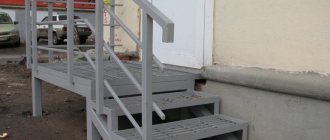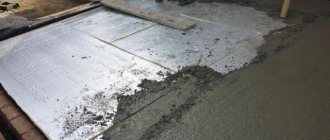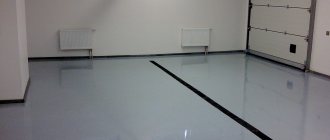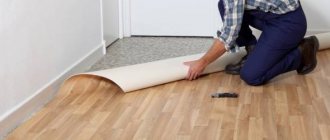One of the many protective functions of any structure is to prevent moisture from entering rooms or technological cavities. When they talk about the dangers of exposure to water, they mean both the direct destructive effect and the harm caused by salts, reagents, and mechanical impurities dissolved in it. To limit the ingress of moisture, individual elements of building structures must be treated with special dense impermeable materials. An important element that requires special attention are the floors in the house. Their structures must be protected both from liquids that spill from above, and from vapors that penetrate from below, from the ground. This task is served by waterproofing a concrete floor.
Why do you need to waterproof a concrete floor?
Concrete is a porous structure that absorbs water and moisture like a sponge and can pass it through itself into the room. For this reason, in the absence of high-quality waterproofing, moisture under the house, groundwater and surface water can easily penetrate into concrete, thereby provoking the following consequences:
- Destruction of concrete - Water contains salts, minerals and various impurities that negatively affect any concrete;
- Formation of cracks in the floor - water is absorbed into the concrete base of the floor and leads to the gradual growth of capillaries and pores in the concrete, which ultimately leads to the formation of microcracks, and then full-fledged cracks in the floor;
- The appearance of mold and mildew - Without insulation, the floor slab will always be damp as it absorbs water, which leads to increased humidity in the room. In turn, high humidity promotes the growth of fungus and mold in the room, which greatly harms human health;
- Flooding – If the floor is not properly waterproofed, then water can flow through it and flood the house, basement or other structure.
Some background information
Concrete, as a building material, has a low degree of water absorption. It would seem that concrete monoliths can stand and stand, but corrosion eats them up from the inside... in the concrete itself.
There are several reasons for the destruction of cement stone. They can occur separately or in combination, causing different types of destruction. Requires protection from water.
If you also insulate problem areas of joints with walls at a level of 0.3 m above the floor surface and transitions with special materials, then you don’t have to worry about destruction of the foundation and leaks.
Kawabanga! Shotcreting of concrete
There are a number of technologies to protect the floor:
- coating materials;
- using metal sheets;
- liquid insulating coating;
- rolled waterproofing sheets;
- dry compositions with a penetrating effect, etc.
The choice of the required technology is influenced by:
How to properly waterproof a concrete floor?
In order to properly waterproof a concrete floor, you need to understand not only what material you need to use for this, but also how to position it correctly. In some cases, protection for a floor made of concrete must be located not only on it, but also under it, in order to prevent water under the house from affecting the concrete and thereby destroying it over time.
Waterproofing under a concrete floor or waterproofing a floor on the ground
It is necessary to apply waterproofing under the future floor when it comes to the floor in the basement of a private house or commercial building.
The main waterproofing of the floor should be located underneath it so that water under a private home or office building cannot affect and soak into the concrete floor itself. To do this, you must first prepare the concrete and then apply waterproofing to it. After applying the waterproofing, a reinforced frame is made and a slab is poured, which serves as the main floor. In fact, waterproofing is not done on the ground, but on concrete and serves as protection for the floor from water and moisture in the ground.
Important: The most common mistake when installing waterproofing under the floor is that the waterproofing is applied directly to the ground or other unstable base, due to which it quickly becomes unusable because it cannot withstand the dynamics of the soil base. Waterproofing must be applied to a rigid and stable base, which is why the first step under the construction of the floor is concrete preparation, on which waterproofing is applied.
Diagram of waterproofing under a monolithic floor:
Scheme of concrete floor installation and location of waterproofing
Waterproofing over concrete floors and under screeds
It is recommended to apply waterproofing over a concrete floor before installing the screed in the following cases:
- When it comes to the upcoming wet area, where the kitchen, bathroom, line room, workshop or other premises associated with the use of water will be located;
- When we are talking about the basement of a private residential building, building or structure.
In the basement, after installing protection under the future floor, the monolithic floor itself is poured directly. Despite the cut-off waterproofing located under the finished floor, it is also recommended to apply waterproofing to the floor itself before installing the screed.
It is recommended to apply waterproofing under the screed, especially if we are talking about wet areas or a floor in the basement or plinth, under which there is a soil layer. This additional protection under the mounted screed essentially serves as a second waterproofing circuit and will be very useful if the first circuit eventually begins to leak water into the basement or basement of the house.
Scheme of waterproofing device for screed
What to pay attention to when performing work
New buildings are characterized by high humidity. Such a microclimate in the house can not only ruin repairs, but also damage the load-bearing parts of the structure. Waterproofing a house is carried out in the following order: foundation, basement (if any), floors. This way you can protect wooden structures from rotting, and metal ones from corrosion.
One of the types of decorative self-leveling floors with protective properties Source zen.yandex.ru
Due to poor-quality waterproofing of the floor of the first floor of a house, doors often suffer. Moisture rises up the wall and saturates the unprotected parts of the wooden frame. The structure loses strength, becomes deformed, becomes loose and begins to rot.
Oil paint or varnish is not waterproofing. Their service life is limited to 4-5 years, after which they begin to crack and crumble. Also, floor tiles cannot be used as a waterproofing material - this is a finishing material.
Types of materials and methods of their application
In order to provide high-quality future protection for a floor made of concrete, you need to choose the right waterproofing material. Next, we will study the main types of materials.
Important: When choosing a suitable material, you should not choose based on the principle that the cheaper the better. In most cases, higher quality materials are more expensive because higher quality ingredients are used in their production and expensive components are added in a higher proportion than their cheap counterparts. Do not forget that if the completed waterproofing is damaged, the cost of redoing it will be at least 2 times more expensive than initially making high-quality insulation, and this does not even count the cost of possible repairs as a result of flooding.
Pasting
This category includes roll products that have an adhesive base and are mounted by pressing the existing adhesive base to the surface. Pasting products are mounted overlapping each other in 1-2 layers.
Pasted insulation
You can download detailed installation instructions by clicking on the link - Installation instructions for adhesive insulation
You can read more about roll systems in the article – Installation of roll waterproofing.
Coating
We are talking about various types of mastics based on bitumen, polyurethane or acrylic. These compounds are applied using a roller or brush in 2-3 layers. When applying each subsequent layer, you must wait until the previous one has dried. The most popular materials in this category are bitumen-based mastics.
Coating floor insulation
Welded
Here we are talking about fused rolled materials. These systems are fused to the surface using a torch. When the bitumen layer melts, the rolls are glued to the base, creating a barrier to water and moisture. When it comes to the floor of a plinth or basement, roll fused insulation is applied in 1-2 layers, depending on the presence or absence of groundwater. The rolls must be fused overlapping each other and when fusing the second layer, overlap the seams of the previous one.
You can read more about roll systems in the article – Installation of roll waterproofing.
Built-up floor insulation
Liquid rubber
Liquid rubber is a bitumen-latex emulsion. Liquid rubber is applied manually by coating or spraying. When ZhR is applied to the surface, a seamless, elastic coating with 100% adhesion to the base is formed. The absence of seams and high elasticity make this type of insulation extremely effective and durable. High-quality liquid rubber can last at least 50 years.
You can read more about liquid rubber in the article “Waterproofing with liquid rubber.”
Cement
Cement compositions are those materials that have a cement base to which various polymers are added. Cement and polymer-cement compositions are applied by coating in 2-3 layers onto a dry or slightly damp concrete surface. High-quality polymer-cement compositions can withstand negative water pressure from outside to inside.
You can read more about cement insulation in the article – “Cement-based waterproofing: Features, types and methods of its application.”
Cement floor waterproofing
Waterproofing additives for concrete
Additives to concrete help improve its properties in terms of strength and water resistance. Additives to concrete must be added at the time of its preparation, strictly following the instructions.
Important: No additives or additives to concrete can change its porous structure and make it completely waterproof, which is why when using any additives it is necessary to waterproof it.
Comparison table of materials
This table shows the advantages and disadvantages of the main materials above. Studying them will help you better understand each material and make the right choice.
| Liquid rubber | Bitumen-based coating mastic | Fused and adhesive membranes | Cement | |
| Working with negative water pressure from outside to inside | No | No | No | Yes |
| Can be applied to wet surfaces | No | No | No | Yes |
| Seams and joints in waterproofing coatings | No | No | Yes | No |
| 100% adhesion to the base | Yes | Yes | No | Yes |
| High elasticity coefficient | Yes | No | No | Yes |
| Effective operation in high groundwater and aggressive environments | Yes | No | No | Yes |
| Warranty period for work | 7 years | 3-5 years | 3-5 years | 7 years |
conclusions
To install a high-quality waterproofing coating under the floor, it is best to use seamless waterproofing systems that have a high coefficient of elasticity and 100% adhesion to the base (so that there are no voids or cavities under the material), and during the dynamics and movement of the structure it does not tear or separate at the seams. stretched.
Examples of such systems:
- Liquid rubber – FlexLock type. Used as a layer between the concrete preparation and the floor, as well as between the floor and the screed. This material cannot withstand negative pressure and therefore requires pressure, for example, using a tie.
- Polymer cement system – HydroPaz Prime. Can be applied to a slightly damp base, which saves time waiting for the concrete to dry completely. It works on negative water pressure, which allows you to use this insulation without the need to press it with a screed, which gives the contractor the opportunity to use it as a finish and immediately lay tiles on it.
Video description
An unusual protection option is a 3D self-leveling floor in the video:
The material is distributed over a primed concrete base in two ways - hot or cold, in several stages. Then the surface is dried with hot air (gas burner, IR radiation). For additional reliability, the layer is reinforced with fiberglass or metal mesh. The thickness of the finished film is from 5 to 15 cm.
Impregnating (penetrating) waterproofing
For protection, solutions of concrete, concrete-polymer or cement composition with chemically active additives (polymers, salts of alkali and alkaline earth metals) are used. This composition is able to penetrate deep into the concrete surface (some 50-60 cm), making it waterproof. You can immediately lay ceramic tiles on top of the waterproofing.
Waterproofing of a wooden floor, logs (beams for flooring) Source bg.decoratex.biz
Repair of waterproofing of concrete floors
There are often situations in which a floor made in the basement of a private building or house begins to leak water into the house or building. If this is so, then this means that the waterproofing of cold joints or the waterproofing of the foundation slab from below (at the concrete preparation) or on it is broken or missing. In this case, repair of these units can be done in 2 ways: 1. Injection waterproofing - using injection, you can effectively seal cold seams through which moisture and water enter first, since they are the weakest point of almost any structure. 2. Polymer-cement or cement waterproofing working on negative water pressure - these compounds are applied to the floor with a slight approach to the walls.
Scheme for repairing floor waterproofing using injection:
How much will you have to pay for materials?
Materials for waterproofing, of course, are not available for free, but among them there are a lot of affordable ones. The purchase of these materials for repairs is quite affordable even for a modest home owner.
Using paint waterproofing
Table. Average cost of some materials.
| Name | price, rub. |
| Hydroisol based on steklohost, 2.5 mm, 9 sq. m. | 400 |
| Uniflex TechnoNIKOL, 3 mm, 10 sq. m. | 1200 |
| Ruberoid, 15 sq. m. | 400 |
| Glassine, 13 sq. m. | 100 |
| Technoelast TechnoNIKOL, 4 mm, 10 sq. m. | 1400 |
| Aquastop - Perfecta, 20 kg (coating) | 650 |
| WaterStop SLIMS, 20 kg | 850 |
| Mastic Flachendicht, Knauf, 5 kg | 1250 |
| Bitumen mastic, 20 kg | 350 |
| Rubber mastic, 22 kg | 1350 |
| Construction bitumen, 25 kg | 600 |
| Bitumen primer, 20 l | 650 |
| Bitumen primer TechnoNIKOL, 20 l | 1800 |
Advice! For reinforced concrete floors in kitchens and bathrooms, it is recommended to use concrete contact and penetrating waterproofing.
Choice of insulation
The first stage is the analysis of thermal insulation technology, which depends on the room. General requirements for the material are low thermal conductivity, resistance to moisture and temperature changes. The arrangement of the finished floor depends on the insulation.
For fibrous, sprayed and partly bulk materials, a hard finishing surface must be installed. If you need to choose how to insulate a concrete floor under a laminate, it is better to use monolithic sheets.
| Material | Thermal conductivity, W/m*K | Density, kg/m³ | View |
| Mineral wool | 0,034-0,05 | Up to 75 | Sheets, rolls |
| Styrofoam | 0,037 | Up to 16 | Sheets |
| Expanded polystyrene | 0,028 | Up to 45 | Sheets |
| Expanded clay | 0,16 | Up to 800 | Bulk |
Popular types of thermal insulation materials:
- Mineral wool. It is made by heat treatment of basalt rocks. The result is hollow fibers that are bound with a special compound. Advantages: non-flammable, retains heat well. Disadvantages - low density, installation of a finished floor is required.
- Styrofoam. Despite the good thermal insulation qualities, it is not recommended to insulate concrete floors with foam plastic in apartments and second floors of private houses. It has low mechanical strength; an additional screed or a system of wooden logs with a floor covering is needed on top of the sheets. This increases the load on the interfloor ceiling.
- Extruded polystyrene foam. Unlike polystyrene foam, it has an increased density (up to 75 kg/m³), which allows you to install a decorative coating on top of it - linoleum, parquet. Advantages: ease of installation, minimum heat losses at the joints. Disadvantages - flammable material.
- Expanded clay. After firing a mixture of clay and shale rock, small balls with a porous structure are obtained. There are a number of restrictions on use, granules absorb moisture well, and to create a good heat-insulating layer you need a large volume of material. You can insulate a concrete floor with expanded clay on the ground floor of a private house, garage or bathhouse.
The use of sprayed coatings (polyurethane foam, ecowool) for a relatively small volume of thermal insulation is impractical. To form a layer you need special equipment, which increases costs.
